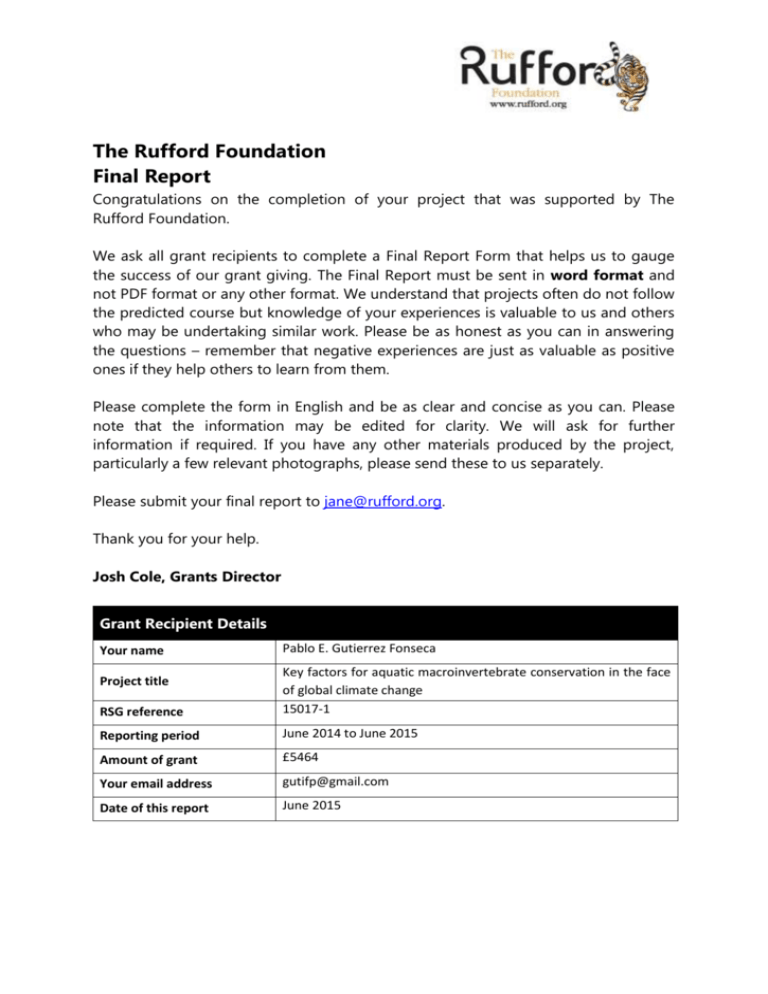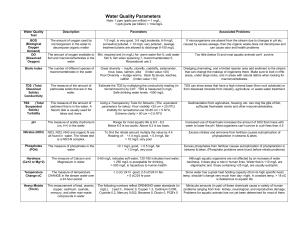Final Report - Rufford Foundation
advertisement

The Rufford Foundation Final Report Congratulations on the completion of your project that was supported by The Rufford Foundation. We ask all grant recipients to complete a Final Report Form that helps us to gauge the success of our grant giving. The Final Report must be sent in word format and not PDF format or any other format. We understand that projects often do not follow the predicted course but knowledge of your experiences is valuable to us and others who may be undertaking similar work. Please be as honest as you can in answering the questions – remember that negative experiences are just as valuable as positive ones if they help others to learn from them. Please complete the form in English and be as clear and concise as you can. Please note that the information may be edited for clarity. We will ask for further information if required. If you have any other materials produced by the project, particularly a few relevant photographs, please send these to us separately. Please submit your final report to jane@rufford.org. Thank you for your help. Josh Cole, Grants Director Grant Recipient Details Your name Pablo E. Gutierrez Fonseca RSG reference Key factors for aquatic macroinvertebrate conservation in the face of global climate change 15017-1 Reporting period June 2014 to June 2015 Amount of grant £5464 Your email address gutifp@gmail.com Date of this report June 2015 Project title 1. Please indicate the level of achievement of the project’s original objectives and include any relevant comments on factors affecting this. Objective Characterise diversity and composition of aquatic macroinvertebrate assemblage in six streams Evaluate the relationship between environmental variables (i.e., precipitation, discharge, episodic acidification events) and aquatic macroinvertebrates Geomorphological characterisation Physicochemical and hydrological characterisation of streams Workshop and student training Develop a brochure about freshwater ecosystems and their vulnerability to global climate change Not achieved Partially achieved Fully achieved X X X X X X Comments We found a total of 64 taxa, which were mostly aquatic insects. Of these, we could identify several taxa that were sensitive or tolerant to changes in the environment. We determined that discharge is one of the most important variables structuring the community of aquatic organisms in streams of protected areas. There was not enough time to achieve this objective. The streams were successfully characterised and the information was used to supplement the biological information. The workshop was a success. The more than a dozen students that attended discussed conservation issues, global climate change, monitoring of water bodies and risks for tropical ecosystems. Informational brochures were distributed among students and teachers who attended the talks. In addition, brochures were delivered to school teachers to distribute among students who were unable to attend the talk. The brochure can be found online at the following website: https://sites.google.com/site/pgu tierrezfonseca/home. Outreach activities for high school and college students, and a public visit X The activities were a success. Many college and high school students attended, some of whom are already monitoring key aquatic ecosystems. 2. Please explain any unforeseen difficulties that arose during the project and how these were tackled (if relevant). There were a few unforeseen difficulties that arose during the project, which is common in ecological field work. Some of the most important are the following: The objective of establishing a geomorphological characterisation of stream channels was a little ambitious for stream conditions and for the timeframe of this research grant. These streams are highly dynamic and experience high floods, so we need to develop a new method of measuring relative turbulence and other related variables. After taking this into consideration, we decided to focus on the characterisation of the flow, stream bed, riparian habitat, and abundance and taxonomy of macroinvertebrates. Some of the high school groups that were coming to the outreach activities were not able to attend due to a delay in excursion passes for the students and other scheduling issues. Informational brochures and other field guides were sent to their teachers to be distributed amongst the students. 3. Briefly describe the three most important outcomes of your project. a. Increased understanding of how environmental variables influence macroinvertebrates. This project has provided key information regarding the importance of spatial and temporal environmental variables and how they influence macroinvertebrate composition in the study area. This is one of the few studies that have focused on how these variables are impacting macroinvertebrates in streams of protected areas. Understanding the importance of natural stressors in an ecosystem is essential for the development of accurate predictions of their future in the face of climate change and other anthropogenic disturbances. Our results indicate that discharge was the most important environmental variable structuring aquatic macroinvertebrates throughout the study period. According to several climate change models, discharge is expected to experience dramatic changes, which will highly impact these aquatic communities. b. Increased taxonomic information. Tropical lowland streams are the least explored and understood ecosystems. These streams harbour many species of aquatic macroinvertebrates. This study contributed to the knowledge of 64 insect taxa, which have been preserved and will continue to be analysed. This will help collect information at a finer taxonomic resolution and also contributes to a reference collection to be kept in Costa Rica. c. Aquatic macroinvertebrates as a biomonitoring tool in schools. A group of students (mostly girls) received dedicated and practical training on freshwater biomonitoring, sample processing to a quality controlled standard and beginner macroinvertebrate taxonomy. As a direct result of their experience, the group has proposed to continue their training; they are currently collecting and analysing macroinvertebrate samples from a region that is affected by strawberry plantations near the Poás Volcano in Costa Rica. 4. Briefly describe the involvement of local communities and how they have benefitted from the project (if relevant). We did not work directly with a local community. However, this project was conducted in collaboration with the University of Costa Rica (San José), Gregorio Jose Ramirez High School (Alajuela) and some collaborators of the GLOBE Program (Global Learning and Observations to Benefit the Environment); GLOBE is an international programme that encourages student scientists to better understand earth processes, the environment and sustainable use of resources. High school and college students received educational talks and hands-on training, which allowed them to develop technical skills and knowledge that is lacking in the area. Some of the students are now planning to apply the learned biomonitoring techniques in climate sensitive areas of high elevations in Costa Rica, where a combination of natural and anthropogenic factors are threatening aquatic ecosystems. 5. Are there any plans to continue this work? This study intended to answer the question of how physicochemical variables affect aquatic macroinvertebrates in tropical lowland streams. With the field and laboratory work that was conducted, we have successfully concluded this study. However, further research in this topic is essential to determine if there is interannual variability in these tropical streams. For example, the year 2015 has already suffered the most rainfall in the Caribbean side of Costa Rica, while the Pacific side is in the most severe drought of the last decade. These extreme events and their impacts on aquatic macroinvertebrates are yet to be measured. In addition, climate predictions suggest that these extreme events will become more frequent, and understanding their effects on aquatic organisms will help improve the development of successful conservation strategies for these vulnerable ecosystems. 6. How do you plan to share the results of your work with others? The main results of this study were already shared in several activities. We offered a talk on April 24th 2015 for the Gregorio Jose Ramirez High School, where students from different grades shared their experience in the study of aquatic ecosystems. This talk emphasised on the challenge of conserving aquatic ecosystems in the face of global climate change. An informative brochure was prepared and distributed during this talk, as well as some other photographic guides. Several copies of this brochure were also donated to the school to be shared among the teachers and other students that could not attend the talk. Some other high schools, such as the Liceo de Paraiso, have expressed interest in receiving the talk and teaching materials, and we are planning on coordinating this activity in the near future. Likewise, the result of this and other related studies was shared on April 28th 2015 in the University of Costa Rica through the Entomological Seminars, where professors and students from various national universities met to discuss relevant issues about the natural sciences and conservation efforts for Costa Rica. Finally, the results of this study will be shared in two scientific articles, which will be published in peer-reviewed international journals and international conferences (MACROLATINOS congress Colombia 2016). 7. Timescale: Over what period was The Rufford Foundation grant used? How does this compare to the anticipated or actual length of the project? The Rufford grant was used from June 2014 to June 2015, when one part of field work was conducted, the samples were sorted and identifies, the data was analysed and the outreach activities took place. Nevertheless, the actual length of the project was longer, since first fieldwork expeditions were conducted in 2011 and some of the samples were already collected when the Rufford grant was received. We are still in the process of writing this study as part of a doctorate thesis and further publication in a scientific journal. 8. Budget: Please provide a breakdown of budgeted versus actual expenditure and the reasons for any differences. All figures should be in £ sterling, indicating the local exchange rate used. Item Collection and sample processing Air travel (3 times San Juan, Puerto Rico to San Jose, Costa Rica), including Departure taxes Budgeted Amount 3249 Actual Amount 2857.3 Difference Comments 391.65 1128 1461.28 -333.28 Sample processing took less time than expected thanks to the experience of the employees. Air transport was higher than expected due to fluctuating flight costs. Room and board (3 times) in San José Transport Airport-UCR and vice versa Supplies (e.g., forceps, ethanol) 451 634.73 -183.73 115 121 -6 96 0 96 Brochures and Banners Total 425 5464 430 5504.31 -5 -40.31 Room and board costs were higher than expected. The material were donated or provided by collaborators *Local exchange rate used: The highest currency exchange rate for the year 2014-2015, according to the following website: http://usd.fxexchangerate.com/crc-exchange-rates-history.html 1.5461 USD = 1 GBP 824.72CRC = 1 GBP 9. Looking ahead, what do you feel are the important next steps? To conduct a comprehensive study on how global climate change might affect aquatic ecosystems, the most important steps are: 1. Continue educating the local community on the threats to biodiversity brought on by climate change and how to minimise its negative impacts on their surrounding environment. 2. Develop partnerships with interested groups to promote the exchange of ideas, materials, and successful collaboration in field work activities. 3. Complete a taxonomic inventory of the site. Knowing which species are present could help determine the species that would be most vulnerable to changes in the environment and develop strategies for their protection. 4. Determine biological changes due to changes in environment variables using ecological water quality indexes. 10. Did you use The Rufford Foundation logo in any materials produced in relation to this project? Did the RSGF receive any publicity during the course of your work? The Rufford Foundation logo was used in all public presentations on the results of this study, including the talk for the Gregorio Jose Ramirez High School and the University of Costa Rica. It was also used in the informative brochure that was prepared and distributed throughout several interested parties (teachers, professors, and high school and college students). The RSGF received publicity throughout the project in this and other ways. I notified several other students about this opportunity, which resulted in two of my colleagues applying for the grant. Finally, the Rufford Small Grant will be acknowledged in all forthcoming publications. 11. Any other comments? This work represents a key step to understand how environmental variables such as discharge and episodic acidification events can affect aquatic ecosystems in streams of protected areas in Costa Rica. The results have helped to develop local capacity for the implementation of biomonitoring tools, which are useful not only in environments impacted by humans, but also in places where natural dynamics go beyond our understanding. This would not have been possible without the support of the Rufford Foundation.






